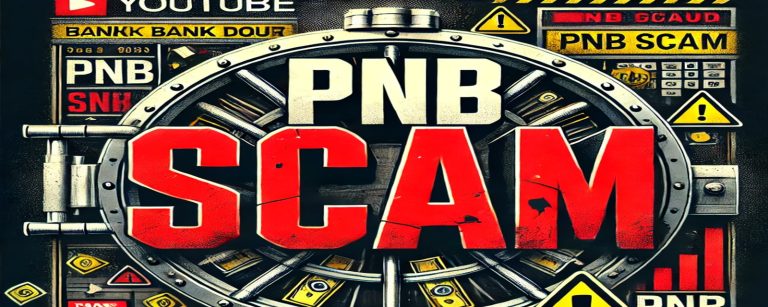The Punjab National Bank scam is one of the most shocking fraud cases that India’s banking sector has witnessed. It surfaced in January 2018, when over ₹11,400 crore in a fraudulent transaction involving prominent personalities such as diamond merchants Nirav Modi and Mehul Choksi were involved. This was the scam at Punjab National Bank’s Brady House branch in Mumbai, where officials issued unauthorized letters of undertaking, which enabled fraudsters to garner huge overseas loans without adequate collateral.
The PNB scam, in simple words, was one of the largest banking frauds committed by Nirav Modi and his associates, along with exploiting loopholes within the banking system. Thus, they could siphon off funding for personal usage. This brought damage not only to the PNB but even impacted the Indian banking sector and associated industries very severely. Let’s dive deeper into the details of this fraud and its mechanisms leading to its consequences.
What is PNB Scam?
PNB scam involved Rs 11,400 crore in fraud transactions and grew to Rs 13,000 crore after its investigation was taken up. PNB scam related to LOU misuse as Letters of undertaking issued by the banks for providing overseas currency loan facility.
In this case, Nirav Modi and Mehul Choksi, the key perpetrators, colluded with PNB employees to secure LOUs without providing adequate collateral. These LOUs were sent through SWIFT transfers (Society for Worldwide Interbank Financial Telecommunication), bypassing the bank’s internal core banking system (CBS). This allowed the fraud to go unnoticed for several years.
SWIFT Transfers and Their Role in the PNB Scam
SWIFT transfers played a central role in the PNB scam, as fraudulent Letters of Undertaking (LoUs) were issued via SWIFT without being recorded in the bank’s core system. This loophole allowed massive unauthorized transactions, enabling the scam to go undetected for years.
What are SWIFT Transfers?
SWIFT is a worldwide network used to make risk-free and reliable cross-border transactions. It provides banks with a network through which they can send messages related to payments or guarantees.
How did SWIFT assist the fraud?
Bank officials of the Brady House branch in Mumbai misused the SWIFT system to issue unauthorized LOUs on behalf of companies owned by Nirav Modi and Mehul Choksi for loans issued by overseas banks such as Allahabad Bank and Axis Bank.
The fraudulent activity happened because there was no linkage of the SWIFT system with PNB’s CBS. This disconnection allowed employees of PNB to send out LOUs without the transactions getting reflected in the main system of the bank. As a result, the bank’s internal audits failed to detect the fraud for years.
Definition of Letter of Undertaking
A letter of undertaking, sometimes called a Bank Guarantee, helps a borrower acquire short-term loans from foreign banks. The issuance bank undertakes the responsibility for the loan recovery on behalf of its client.
How LOUs Were Abused in PNB Fraud Case
Companies owned by Nirav Modi and Mehul Choksi received LOUs from PNB without providing the necessary collaterals. Corrupt PNB officials, while negating regulation, issued such LOUs fraudulently. Banks in foreign countries, relying on the guarantees given by PNB, provided loans to companies owned by Nirav Modi and Choksi.
The loans were never recovered, and the foreign banks awaited ₹11,400 crore, which PNB was liable for. This is the misuse of LOUs; it formed the backbone of the Nirav Modi fraud case.
How the Perpetrators Were Caught?
The PNB scam came to notice in January 2018 through a recruit at PNB who detected issues in the issuance of LOUs. The employee pointed out the fact, which raised an alarm internally within the bank. The scam was exposed by Investigation. PNB discovered that its LOUs had been issued over years without the required authorization. Two employees from Brady House were said to be involved, which included Gokulnath Shetty and Manoj Kharat. The fraudsters manipulated PNB’s system to allow the companies owned by Nirav Modi and Mehul Choksi. The CBI and ED began to investigate the fraud. They discovered financial irregularities and traced the money trail to offshore accounts and shell companies.
Legal Angle: The Actions Taken
The PNB fraud case triggered multiple legal actions to hold the perpetrators accountable and recover the lost money.
FIRs and Arrests
The Central Bureau of Investigation (CBI) had also filed an FIR against Nirav Modi and Mehul Choksi besides other top executives in PNB related to the scam. Some officials in PNB have already been behind bars, including Gokulnath Shetty and Manoj Kharat.
Assets Seized
The Enforcement Directorate (ED) seized the assets of Nirav Modi, Mehul Choksi, and their group companies worth thousands of crores. Properties, jewelry, luxury goods, and bank accounts were some of the items taken in the case.
Fugitive Economic Offenders Act, 2018
India brought in the Fugitive Economic Offenders Act, of 2018, for cases like the PNB scam. Nirav Modi and Mehul Choksi were declared fugitive economic offenders under this law, which allowed the government to seize their properties even if they were outside India.
Impact and Effects of the Punjab National Bank Scam
The Punjab National Bank scam accounted for ₹11,400 crores. All these had a major impact on sectors such as banking in India, stock markets, and related industries, and the impacts were felt over the economy leading to several reforms in financial governance. The several effects of this massive scam related to the Punjab National Bank have been discussed below.
- It responded very sharply on the stock market too. With Punjab National Bank disclosing the fraud in February 2018, the stability of the entire banking sector came into question. Punjab National Bank stocks tumbled more than 40%, wiping away thousands of crores from investors’ pocketbooks. Panic broke out among the retail and institutional investors fearing that something like this might repeat itself in some other public sector banks as well.
- It spilled over to other PSBs, while the stocks of banks such as SBI, Bank of Baroda, and Allahabad Bank plunged steeply because investors were alarmed about undisclosed NPAs and internal controls within the sector.
Deterioration of Investor Confidence
This eventually made the investors lose faith in the Indian banking sector regarding the transparency and governance of such sectors. Moreover, this scam created the awareness of future potential scams and misuse, thereby the investments in bank and financial service stocks reduced drastically.
Effects on Foreign Investment
Institutes with overseas branches were very concerned regarding raising their shareholdings in PSBs as well. Further, the FIIs decreased the inflow of foreign capital to the Indian banks.
Damage Continued in Market Sentiment
Negative emotions stayed there for months; meanwhile, investor confidence was very hard to regain for PNB. The market capitalization of PNB fell by more than ₹10,000 crores within weeks which made it the biggest corporate fraud loss ever recorded in Indian financial markets.
Impact on LIC
The share value of Punjab National Bank that the LIC had remained in it took a strong financial blow from the scam. Shares are an asset that it owns over various public sector undertakings, such as banks, hence is directly prone to market fluctuations as caused by frauds like the PNB scam.
- Sudden Severe Dropping of Portfolio Value: LIC’s stake in PNB had led to an immediate loss due to the falling stock price of the bank. The portfolio value of the insurer plummeted drastically, raising fears about its vulnerability to public sector banks marred by bad loans and frauds.
- Erosion of Public Trust The LIC is perceived to be a risk-free and risk-secure investment for millions of Indians. Yet, the financial jolt that it received as a result of its exposure to PNB put its risk management into question, besides its role in safeguarding public funds.
- Policyholder Concerns: Though the scam ensured that policyholders’ money was safe, it made aware the world of inter-linkages of risks between financial institutions and the insurance sector. The question now raised before policyholders against LIC’s investment strategy led to the corporation strengthening governance.
- Review of LIC’s Investment in PSBs LIC’s massive investments in PSBs, such as PNB, SBI, and others, were under the scanner. Critics questioned whether it was prudent for LIC to invest heavily in PSBs when the sector was plagued by high NPAs and fraud.
Impact on Jewelry Stocks
The PNB scam also directly affected the jewelry sector because the two major culprits, Nirav Modi, and Mehul Choksi, belonged to this sector. Their role in the fraud jolted the jewelry market also, which influenced investor sentiments, corporate governance within the jewelry firms, and consumers’ trust.
- Downward Trend of Jewelry Stocks: Several publicly listed jewelry companies became victims of this scam. Stock prices for several companies in the luxury jewelry industry took a drastic downturn. The prospect of more inquiries and regulations resulted in a sell-off of jewelry stocks by investors.
- Harm to the Reputation of the Industry: It damaged the prestige of the whole jewelry trade. Nirav Modi and Mehul Choksi had luxury jewelry brands, and their frauds, terrified consumers as well as investors about their next investment in a jewelry firm. The scam unearthed the transparent and proper handling of finance by the industry.
- Economic Impact on Exports: India is among the largest exporting countries of jewelry and precious stones. The scam broke the global buyer’s confidence in Indian jewelers, reducing the export orders and revenues for the industry. International clients started demanding more stringent compliance and certification from Indian jewelry exporters.
- Eroding Consumer Confidence: After Nirav Modi became synonymous with the scam, people began to question the luxuries of jewelry brands. Consumers questioned the authenticity and finances of high-end jewelers, and this led to reduced footfalls in their stores and reduced sales growth.
More Economic and Systematic Impacts
Even though the scam has a direct impact on Punjab National Bank, LIC, and the jewelry sector. But it has had an overwhelming impact on the Indian economy and banking system:
Undermining public confidence in banks
The PNB scandal thus undermines public confidence in the soundness of Indian and public sector banks. Many account owners panic about the safety of their deposits. This is a valid reason for the distrust in the current banking system that most people spread…
Regulatory and governance issues
The scandal has exposed huge gaps in regulatory oversight and oversight in the Indian financial sector. It noted how easily fraudsters could exploit such vulnerabilities when the SWIFT system is not integrated with the core banking system.
Increase in NPA
The NPA boom in India has also been boosted by another scam. PNB alone lost ₹14,000 crore in the fiscal year immediately after the scam. As a result, the NPA crisis in public sector banks has worsened.
Government pressure
This increases the government’s urgency to reform PSBs and bring responsible rogue officials to justice. Since then He has been widely criticized for questioning the government’s role in managing PSBs and protecting taxpayers’ money.
Notification for stakeholders
The PNB scandal has raised alarm among several stakeholders in the Indian economy:
- For banks: the urgent need for strict internal controls system integration as well as good banking practices has been demonstrated.
- For investors: This is to review the level of corporate governance and bring to their attention the transparency concerns of the companies in which they invest.
- For regulators: The RBI along with other regulatory agencies is necessary.
PNB Scam FAQs
Q1. What is the PNB scam?
The PNB scam was a ₹11,400 crore fraud in which Nirav Modi and Mehul Choksi took advantage of loopholes in Punjab National Bank’s system to draw unauthorized loans.
Q2. Who brought the PNB scam to light?
The scam was discovered in January 2018 when a PNB employee found inconsistencies in the LOUs issued at the Brady House branch in Mumbai.
Q3. What is the Fugitive Economic Offenders Act, 2018?
The Fugitive Economic Offenders Act, of 2018, provides the authorities with the right to confiscate the properties of individuals who flee India to evade prosecution in cases of economic fraud.
Q4. What impact did the scam have on PNB?
The scam led to financial loss, and reputation loss, and the stock value of PNB drastically declined.
Q5. What measures have been taken to avoid such fraud?
Banks have integrated SWIFT systems with core banking, improved audit mechanisms, and regulatory oversight to avoid frauds like the PNB scam.


